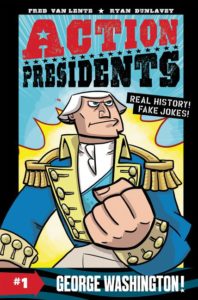Comic Book Review: Action Presidents: George Washington by Fred van Lente and Ryan Dunlavey
Our story begins with two modern tweens glued to their portal screen devices while Parson Weems bores them with the cherry tree legend. The day is salvaged when Noah the Historkey appears and reveals that George Washington’s father Augustine didn’t raise cherries, but tobacco! And that’s just one of the many awesome facts the bird of history reveals about the life of the first president of the United States.
As Noah explains, a lot of history books for kids “talk about the past as though it’s a movie you already know the ending to — or a fable that’s supposed to have some sort of moral at the end.” But this comic book tells the true story of President Washington with extra jokes to leaven the seriousness.
And there’s plenty of serious stuff to get through. Washington was a soldier, and eventually a general–and he didn’t always win his battles. His health was poor as time went on, especially his teeth. There’s all the work that went into the Constitution to try to make the new country’s government work, and the stormy years of the Presidency.
And of course the elephant in the room. George Washington was a slaveowner from the age of eleven, at one time possessing 318 human beings as property (many through his wife Martha’s dowry.) He’d always accepted this as perfectly normal, but experiences in the American Revolution began to change his mind. (This book sets that change around the time of Valley Forge.)
Washington’s realization that slavery was morally wrong conflicted deeply with his economic reality in which slaves were needed to do all the work at Mount Vernon and bring in the crops. In the end, he compromised by freeing his slaves in his will…but only after Martha died too. (Martha decided to speed up the process and start freeing them only ten months after George passed on.)
George Washington did many good things, including not seizing power after the Revolution, and setting a precedent for restraint in office. He also did bad things. This comic book suggests that knowing all of this makes him more interesting than the whitewashed version some pundits prefer.
The art is dynamic, and many of the jokes are funny. Some parents may object to passing body function humor, and others skittish about the depiction of violence, and slavery as a flaw in American history. Fourth graders on up should be able to enjoy this book with the help of the glossary in back. There’s also a map of important places George Washington went, a list of things named after the president, and a short bibliography of other books to read (some of them for much older audiences.)
This would make a good starter biography for your budding history major, and George Washington fans in general will find it a worthy addition to their collections. The hardback edition has a sturdy binding so you may be able to find it in elementary school libraries as well.
Later volumes cover Abraham Lincoln, Teddy Roosevelt and John F. Kennedy.

